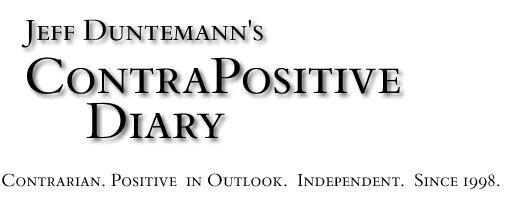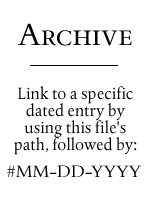|
|
|

|
 October
31, 2006: Designing Novels, Part 2: Characters October
31, 2006: Designing Novels, Part 2: Characters
There was a time when characters didn't matter much in SF. The
gimmick and the plot were primary, and the characters were named
shadows that moved with the plot like wood chips floating downstream.
A lot of the pulp fiction from the 40s and 50s that we now consider
unreadable is unreadable for that reason: The hyperdrive is on,
but nobody's home.
Although an occasional reviewer will plaster a book for being boring,
most of the complaints lodged against modern SF have to do with
characters, and what this tells me is that people are now looking
for characters more than gimmicks or situations. There's a serious
danger here, in that characters without interesting backgrounds
or anything to do basically become soap opera, and a great deal
of modern SF is costume soap opera, especially series fiction. Situation,
characters, and plot are all essential, and in the finest fiction
they are woven seamlessly together in a way that makes you gasp
when you spin past the last page, wishing it would go on. Of course,
one thing that makes good fiction good is that it knows where to
stop, even when the readers are left aching for more. The only thing
worse than not getting what you want in this case may be getting
it.
Alas, nobody's equally good at everything. I'm as bad at crafting
characters as I am good at coming up with tech gimmicks. Nonetheless,
I've found that I've become better with practice and conscious direction
of the characterization process. I need to say here that most of
what I know about characterization I learned at the knee of SF writer
Nancy Kress, who lived nearby and was a close friend when we lived
in Rochester, New York 25 years ago.
Human characters are simulations of human beings. (Most SF aliens
are human beings in rubber suits, which is one reason I don't have
many aliens in my fiction. Like, almost none.) They have strengths,
passions, weaknesses, and personality quirks. You have to be aware
of all of these, and keep a character's actions in line with the
personality that the reader is given to understand. Good characters
grow with the action of the story, as they bump their heads on plot
twists and their own limitations, and that may be the toughest aspect
of characterization that you'll face.
What I have learned to do, and which works well for me, is to create
a sort of character dossier for the most important people in a story.
Basically, you sketch out a character's personality. This is not
what the person does, but what that person is. It
doesn't take a lot of words to do this, and in fact if you run on
too long you can get in various kinds of trouble. Here are a couple
of dossiers from the novel I'm currently working on, The Anything
Machine:
Howard Himmel Banger:
Age 14, son and only child of Stella Price Banger. Average height,
muscular, shaggy brown hair. Has an inborn talent for pictorial
art and illustration but is unsure what sort of career to pursue.
Geeky and systematic, he likes to categorize and sort concepts.
(His mother is pushing him toward an information science career
in content management; basically, to be a librarian.) Prone to
nightmares after his father was murdered when he was only seven.
A little selfish, less emotionally mature than Gustavia. Not especially
confident except when pursuing his passions, and then he approaches
mania. Has known Gustavia since they were toddlers in SUNY faculty
daycare, and assumes that she will spend her life with him, whether
they manage to return to known space or not.
Gustavia Marya "Gusty"
Kowalczyk:
Age 14, daughter and youngest child of Gustav and Anna Kowalczyk.
Short (5'4"), thin, blonde, athletic, gray eyes, pretty without
being dazzling. Intends to pursue degrees in economics and business
and then teach at SUNY Numenor. Willful, very focused on her studies
and her career, and careful lest she make a mistake that will
impact her future. Fascinated by animals and the business of agriculture.
She struggles with her feelings for Howard, torn between her awakening
hormonal attraction to him and her fears that he will not take
the place she has outlined for him in her plan for her own future.
The danger in writing character dossiers is not too little but
too much. The idea is partly to seed your subconscious machinery
with the outlines of a character, and in part to have something
to measure a character against as a story unfolds. Both functions
depends on how your own subconscious mechanisms work and how you
manage them. Characters have a well-known tendency to "grow
away" from your original conception of them. This can be a
problem, but it can also be borderline miraculous. For example,
my early plot outline of The Cunning Blood had no major character
named Jamie Eigen. Jamie was at first a nameless spear carrier,
a sounding board for Peter while he was in jail. But my subconscious
clearly had other plans, and Jamie quickly evolved into perhaps
the single most pivotal character in the whole yarn.
Too much detail in a dossier can lead to conflict between what
your subconscious wants to do with a character and how you consciously
perceive that character. It's best to leave a character dossier
a little bit sketchy, so your subconscious mechanisms have room
to move. Yes, that's a tightrope walk, and you'll have to zero in
on the sweet spot through practice. Again, my intuition is that
it's better to say too little in a dossier than too much.
Avoid the temptation to include in a dossier what characters do.
Howard discovers the Thingmakers, and creates an index that later
evolves into Banger's Big Book of Drumlins ("drumlins"
being artifacts produced by the mysterious Thingmakers) but those
are plot elements, not character aspects.
Nancy Kress always told me that it's important to understand what
each character wants. This is implied by a good dossier,
but sometimes it's useful to look at a character from an extreme
height: Young Gusty Kowalczyk wants life to be predictable; young
Howard Banger wants life to make sense. Most of what they do (and
much of the conflict between them) follows directly from those high-level
differences. If you can understand your characters that deeply,
you can probably do good things with them. So far I'm having a lot
of fun, and the story (which is a juvenile; a first for me) is evolving
well.
More next entry.
|
 October
29, 2006: Designing Novels, Part 1: The Gimmick October
29, 2006: Designing Novels, Part 1: The Gimmick
I've been meaning for some time to talk a bit about the process
by which I design novels. I don't claim that this is the only way
to make a novel, but it's the way my stories come together in those
odd back-of-the-head places that I can only barely perceive.
And that's a good place to start: Novels are emergent processes.
You don't design one quite the same way you design an electronic
circuit. From my experience with my own work in novels (I've written
several, though only one is published) and from talking to other
people who do it, something like this happens: You toss a certain
number of consciously designed elements into the chipper/shredder
in the back of your mind, and then you open the gates to see what
comes out. Some people toss more consciously designed elements into
the chipper than others do. Some people just start writing, and
after a few thousand words take a break to see if what has emerged
has any value or is just incoherent mulch.
I've tried it both ways, and at many points along the gradient.
As usual, there's a sweet spot in the spectrum, where the degree
of conscious design is just enough to feed the individual characteristics
of the mad chipper/shredder operated by your subconscious. Too much
design, and the chipper gums up and the process grinds to a halt.
Too little, and the chipper spits back incoherent blather that never
coalesces into anything you could call a story with a straight face.
Where do you start? I always begin with what a call The Gimmick,
though many call it The
McGuffin. I don't like the term "McGuffin," because
it implies something that advances the plot without being especially
relevant to it. A good gimmick lies at the very core of all the
conflict that besets your characters, and it may well be the thing
that your readers remember years after reading the story. Gimmicks
are extremely important in SF and often in fantasy as well. (Literary
fiction generally dispenses with gimmicks entirely, and relies completely
on characterization.)
The gimmick in The
Cunning Blood is not so much the Sangruse Device (an intelligent
nanocomputer) as it is a planet where electrical things don't work.
They don't work because of a bacterium-sized nanodevice that homes
in on the magnetic fields generated by electrical currents of useful
intensity, and breaks down the metal of the circuit's conductive
elements until the current stops flowing. Earth authorities (who
designed the nanodevice and turned it loose on a nearby Earthlike
planet) assume that this condemns those who live on Hell to a sort
of pseudo-Victorian gaslight existence. What they forget is that
there are more paths to high technology than the electrical ones
that Earth followed. Diesel engines, chemical lighting, photochemical
amplifiers, mechanical and fluidic computers, fiber optics, they're
all in there—and they're all real. Where electricity is crucially
important, the Hellions use wires consisting of liquid mercury in
thin hoses. The current-sensing nanomachines can't disrupt liquids.
I could have spun a lot of stories around that one gimmick, and
I may do one or two more. The point is that it's a good gimmick,
and a memorable one. I put a lot of energy into researching it,
and many people have told me that Hell sounds completely plausible
and real to them.
You come up with gimmicks by paying attention to the physical world.
I read a lot of science, a habit I got into when I was in high school,
and Isaac Asimov was publishing a fat paperback full of fascinating
science essays every few months. I had a nose for the odd corners
of science and technology, especially the ones that never made it
into the mass market. Popular Science ran an article about
fluidic computers when I was in high school. I read as much about
Babbage's mechanical computers as I could as soon as I heard about
them. You do this for a few years, and stuff starts to precipitate
out of that mass of intriguing facts in the back of your head.
I keep a notefile of gimmicks, and add to it when odd things occur
to me. Could an astrobleme
have such high walls that the atmosphere would be different inside
the bleme than outside? I think so. It's a gimmick. I may never
use it, but it's intriguing. Could hacked bacteria separate isotopes
of metal salts dissolved in seawater? I don't see why not. Not every
gimmick is big enough to hang an entire novel on, but there's no
law saying that a novel can only have one gimmick.
Once your gimmick is in hand, you have two ways to go: You can start
playing what-if, to see what would happen if the gimmick were made
real and turned loose, and then build a plot around the consequences.
Or, you can design a cast of characters and see how that gimmick might
affect them, which would then suggest a plot. Stories have been done
both ways. We'll talk more about that in my next entry here.
|
 October
27, 2006: Duntemann's Brain October
27, 2006: Duntemann's Brain
 My
sister Gretchen just sent me what may be an early Christmas present:
A slightly squishy, crawling, humming, snarling audioanimatronic
plastic brain...with teeth. It arrived an hour ago and was not anticipated,
but it's been a lot of fun. My
sister Gretchen just sent me what may be an early Christmas present:
A slightly squishy, crawling, humming, snarling audioanimatronic
plastic brain...with teeth. It arrived an hour ago and was not anticipated,
but it's been a lot of fun.
It senses nearby motion and sound, and when triggered, it hums
a manic little tune for several seconds while crawling forward about
a foot. Then it stops, opens its mouth, and starts snarling and
slobbering.
We instantly knew what to do with it: We turned it on and put it
down on the floor. QBit bent down to sniff it (I'm sure he was wondering
which end to sniff and why there wasn't a tail to sniff under) and
when he set it off, he jumped two feet straight up. A second try
evoked the same response, and since then he gives it a doleful look
from a considerable distance.
We've named it Duntemann's Brain, and it will actually earn its
keep around here. QBit has become a very avid table surfer, and
any time neither of us is in the room, he will hop up on the kitchen
table and start licking the spots on the placemats where I've spilled
spaghetti sauce or chicken soup. Then he jumps down with one or
more placemats in his mouth, and will drag them off to his lair
under the bed if we don't catch him first.
Simply put, Duntemann's Brain will become our kitchen table placemats'
bodyguard. In between meals, it will sit there to one side of the
salt shaker, waiting for QBit to mount the table. Our only concern
is that he will break something trying to get away when it goes
off and starts humming and snarling.
Thanks, my good sister. This one's a keeper. Now, who will hack the
mechanism to make it sing "Let There Be Peace on Earth"
or "I Ain't Got No Body" instead of humming?
|
 October
26, 2006: What Sells on Lulu? October
26, 2006: What Sells on Lulu?
Test Prep. Programming. Diets. Dogs. Lately, a technical manual
for the 737 airliner. Almost anything but fiction.
It was a useful ten minutes I spent earlier today, studying the
top 100 sellers on Lulu.com, the print-on-demand and digital
content gumball machine that I'm going to be using for a number
of projects in coming months. Some thoughts:
- Nonfiction rules. Of the top 100 books, I count only six
that are fiction, including one written by a nine-year old. Admittedly,
#5 and #10 are fiction, but the next tale down is #45, and the
last three are all south of #80.
- Most of the books have competent or even professional looking
covers. It's impossible to know how they came by their covers,
but I was expecting a lot of pastel cardboard with words on it.
Not so. Good photography, good design—it makes me wonder
how many of these books are "long tail" reissues of
books originally released for the retail store market with professionally
designed covers.
- Many of the topics are things I would consider useful, if not
for myself than for at least a significant if small audience.
Examples: That
Military House: Move It, Organize It, and Decorate It.
Nobody moves more often than military folk. This book is a natural.
Or: Intermodal
Shipping Container Small Steel Buildings.
How to make buildings out of used shipping containers. Hey, if
you need to do that, you need this book bad. Or: Plone
Live; basically, a user guide for the Plone content server.
There's a fair bit of whacko stuff in the top 100; typical of
which is How to
Become an Alpha Male, dubbed "The lazy man's way
to easy success with 20 or more women a month." (Good lord.)
But I was amazed at how reasonable and practical most of the top
100 nonfiction titles were. Narrow, yes. (There's an entire
book devoted to helping Catholics resist the temptation to
masturbate!) But—heh— practical.
- There's not much turnover at the top. Lulu has a "this
week, last week" display that shows how the top 100 titles
have changed rank, and (for the most part)...they don't. What
was #1 last week is #1 this week. Indeed, of the top 30, only
two books changed rank at all. (#5 and #6 changed places.) Most
books change rank by one or two positions only. The big exception
is The Boeing
737 Technical Guide, which is up 27 positions this week.
Consistent ranking over time suggests consistent sales. We aren't
told what the absolute numbers are, but I suspect that they're
constant, if modest.
I'm pleased with the way Lulu works. It looks like people are having
some success with it. Again, this is what the future looks like for
niche publishing. I'm going to try uploading a book there tomorrow.
Cross fingers. I'll keep you informed.
|
 October
25, 2006: Lulu as a Digital Gumball Machine October
25, 2006: Lulu as a Digital Gumball Machine
I don't think I've talked about this yet, but having researched
them in some detail, Lulu is
probably the closest we've yet come to a digital "gumball machine."
You can publish an ebook (or any kind of digital content, including
music, photographs, or software) on Lulu, and simply pay them a
20% commission on each copy sold. No other charges. Most other services
that I've researched take a lot more than that; some over 50%. The
effective minimum charge per item is $1, on which Lulu takes 20
cents. You can charge less than a dollar if you want, but the commission
remains at a minimum of 19 cents.
Costs are a lot higher if you want them to print and fulfill paper,
of course, so I'm wondering how many people would be willing to
buy an ebook laid out for 8 1/2" X 11" pages, and then
print it locally. I've been asked to write an article about my
homebrew 2-tube 6T9 stereo amplifier, and if I did I might do
it that way: A 24-page booklet with schematics, photographs, and
detailed instructions, including a parts list with where to get
the parts. You could either read it from your screen or print it
on paper so it could lie flat on your workbench. I'd sell it for
$2 on Lulu, and make $1.60 on each download. I'd be happy with that.
The research is long done, the schematic is already drawn, and writing
is easy for me. If I made $100 lifetime on it I'd be happy.
Lulu seems to be doing well, and once the world at large understands
that they're doing well, there will be competitors, and author costs
will go down. We may finally be coming to a day where niche publishing
can actually make money. I'm close to getting my first title mounted
on Lulu, and you'll read all about it right here.
|
 October
24, 2006: Another Unknown Earworm Captured October
24, 2006: Another Unknown Earworm Captured
One of the great unsolved problems in computing is what they call
"query by humming;" that is, the recognition of melodies
based on inexact reproduction of those melodies. Google has allowed
me to hunt down a great many odd things, like the old "Elmer
the Elephant" kids' show in Chicago, or "Video Village,"
one of the first modern TV game shows, which was Monty Hall's debut.
However, it won't help me with a handful of catchy melodies that
I have tucked away in the back of my head, some dating back a long
way.
I caught one of these "earworms"
recently, though it wasn't easy, and didn't depend entirely on the
melody. When I was very young (figure late 1950s) I remember seeing
a musical cartoon on one of those ancient Saturday morning "cartoon
shows" that had no host or anything but people at the TV station
putting on one old theatrical cartoon after another. The cartoon
I was thinking of was a mixture of animation and live action, with
a real guy playing the piano, and a stop-motion animated big-eared
gremlin dancing around on the piano to an extremely catchy
jazz tune.
What allowed me to catch the earworm was a single memory: At the
end of the cartoon (or maybe the beginning) was the word "Puppetoon"
in large letters. Google took that and led me to George Pal, who
was also the major force behind the special effects in the seminal
1950 film Destination
Moon. (Chesley Bonestell did the background matte paintings.)
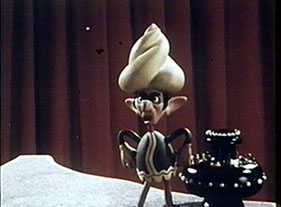 George
Pal created an animation technique we now call "replacement
animation," in which the animators basically create an
erector set of different body parts in different positions for an
animated character, and reassemble the character for every (or almost
every) frame. He did a whole series of Puppetoons using this technique
for Paramount in the 1940s, including a couple of pretty famous
ones, like "Tubby the Tuba" and "John Henry and the
Inky-Poo." I poked around on Google through lists of the numerous
Puppetoons. One of them, "A Date with Duke," featured
Duke Ellington, a master of jazz piano, which seemed promising given
the jazzy piano soundtrack. Sniffing around links containing "A
Date with Duke," I landed on this
page, and there it was: The
dancing gremlin that I remember clearly. (The rightmost of the
four stills.) George
Pal created an animation technique we now call "replacement
animation," in which the animators basically create an
erector set of different body parts in different positions for an
animated character, and reassemble the character for every (or almost
every) frame. He did a whole series of Puppetoons using this technique
for Paramount in the 1940s, including a couple of pretty famous
ones, like "Tubby the Tuba" and "John Henry and the
Inky-Poo." I poked around on Google through lists of the numerous
Puppetoons. One of them, "A Date with Duke," featured
Duke Ellington, a master of jazz piano, which seemed promising given
the jazzy piano soundtrack. Sniffing around links containing "A
Date with Duke," I landed on this
page, and there it was: The
dancing gremlin that I remember clearly. (The rightmost of the
four stills.)
The soundtrack for "A Date with Duke" was Ellington's
own "Perfume Suite," which I researched, and found to
contain several movements. I researched each of the movements in
turn, trying to find somebody with a sample I could play. The first
few I movements I found samples for were too slow to be the tune
in question. Then I went after "Dancers in Love: A Stomp for
Beginners." The first sample I found was, somewhat oddly, played
on classical guitar. It seemed right but I wasn't sure; the
part of the melody I remember most clearly wasn't there. After much
additional poking around, I finally got here,
and played the WMA28 sample of "Dancers in Love." Bingo!
That was it! I still haven't found the cartoon—it would be
fun to see Ol' Big Ears dance again—but at least I was able
to nail a CD of the music itself.
So. Whythehell does it have to be so hard? Why can't I just whistle
the melody into my headset mic and let an algorithm name that tune?
It took over an hour of detective work (though I will admit, I learned
a few things, as I always do during that kind of detective work) and
the detective work had very little to do with the melody itself. David
Stafford says it's a very difficult problem to solve, and he's solved
some doozies. Sooner or later, however, it's gonna fall. Let's hope
it's within my lifetime; that's one earworm down, but there are still
a few more knocking around in there.
|
 October
23, 2006: Why Executive Salaries Can Explode October
23, 2006: Why Executive Salaries Can Explode
I've begun to see a great many head-scratching articles about the
explosion of executive compensation in the last eight or ten years,
especially at very large corporations, while general staff compensation
has stagnated or dropped. The puzzle is why people are puzzled;
it seems pretty damned obvious to me. Three forces are at work here:
- We have gone from a general labor shortage in the developed
world to a general labor surplus. Demand for labor peaked right
after WWII, and now supply has caught up with demand. This may
not be cyclical but structural, in that the demand for labor post
WWII was a one-time consequence of industrialization leading population,
at least in those places where industrialization was happening.
Because labor markets are truly markets, compensation for workers
outside the executive suite is dominated by the effect of this
labor surplus.
- People at the top of large corporations in effect set their
own salaries, because corporate boards, which set executive compensation,
are composed almost entirely of other highly-paid executives or
retired executives. They look at executive compensation questions
and see their own interests in their answers. Nor do the numbers
I see indicate that higher executive pay yields higher financial
performance of the corporation as a whole. The market doesn't
work here.
- Although CEO compensation numbers seem high to the rest of us,
compared to the overall revenues of massive corporations, a few
or even many millions of dollars is small change. Paying the CEO
fifteen mil a year won't crash the company, and dropping CEO pay
to, say, one or two million a year wouldn't help the company,
if revenues are in the billions. On the flipside, when you have
tens of thousands of employees, giving them all a significant
raise could cost a hundred million dollars or more, which would
affect overall corporate viability.
None of this makes it right; it just explains how it's possible.
And that said, the curves are not moving in the right direction:
Revenues generated by continuing productivity gains are flowing
toward the top in an ever more concentrated fashion, probably because,
with markets controlling labor costs, it's easy for them to do so.
I don't know what the answer is. I like game theory solutions to problems
like this, and one suggestion might be to set corporate tax rates
by algorithm, where the lowest tax rates apply when total compensation
dollars spent are most broadly distributed across all employees. I
doubt that that's politically possible, but it's an interesting notion,
and might encourage closer monitoring of executive compensation by
shareholders.
|
 October
22, 2006: Gouache, Tempera, and Elmer's Paint October
22, 2006: Gouache, Tempera, and Elmer's Paint
I inherited a lot of things from my mother, but her intuitive knack
for fine arts (she painted well and worked in ceramics) didn't come
down to me, dammit. So apart from a short no-credit "enrichment"
course in college that exposed me to silk screening and acrylics,
I have almost no experience in painting. So while it's still unclear
what sort of paints were used to paint the very early covers in
Popular Electronics (see my entry for October
20, 2006) I learned a great deal about artists' paints by fielding
the resulting email traffic. Consensus is that they're not classic
watercolors, and may be one of the following:
- Tempera is a species of water-based paints using a binder
made of egg yolk. Tempera doesn't allow the sort of deep color
saturation that oil paints or acrylics do, so it can superficially
resemble watercolor. If I had to guess what Ed Valigursky was
using on those old PE covers in 1955, this would be it.
- Several people suggested gouache, which is a denser but
much crankier species of watercolor, in which the pigment particles
are larger and there is less water in the paint. Gouache is more
used in geometric Miro- or Klee-style paintings or posters than
in classic "fine art" paintings in which individual
brush strokes combine to form a holistic image. The nature of
gouache paints require that they be used quickly, suggesting a
presence in commercial art. However, the drying process affects
the appearance of the pigments peculiarly, and they are notoriously
hard to control across multiple painting sessions.
- George Ewing was the only one to mention casein paints,
which amount to pigmented and slightly thinned out Elmer's Glue
based on a casein binder extracted from milk. I had never heard
of these, but research indicates that they have been used since
the time of the ancient Egyptians. They cover completely and can
be as deeply pigmented as oils.
Michael Covington pointed out that shiny paintings are much harder
to photograph than paintings having a matte finish, so commercial
art would be more likely to use a non-oil process like tempera. Sooner
or later I'll hear from an older commercial artist who can nail the
question. We'll see.
|
 October
21, 2006: Odd Lots October
21, 2006: Odd Lots
- The cap I mentioned in yesterday's entry is apparently a US
Army M-1951 field cap (more formally, the "Cap, Field, Cotton,
Wind Resistant, Poplin, M-1951") or perhaps a WWII German army
M-43 or M-41 field cap, which look pretty much the same. The M-1951
was used from Korea well into Vietnam, when it was retired in
favor of a military ball cap. It's unclear whether the Americans
or the Germans invented the cap, though I think it may well have
been brought here from a galaxy far far away, where it was standard
dress for Empire starship drones. The cap recently re-appeared
as part of the Army's BDU (Battle Dress Uniform) though apparently
only in camo. Thanks to Robert
Bruce Thompson (and several others) for putting a name on
it, after which Google did the rest. I like the fold-down ear
flap, which could be real handy up here in the mountains.
- Also pertinent to yesterday's entry, the cover artist on those
Popular Electronics covers was Ed Valigursky, who was a
very popular SF cover artist in the 1950s and early 1960s, and
also did covers for Argosy and Saga. No surprise
where that square jaw came from, heh.
- Karen Cooper says that the covers (again, from yesterday's entry)
are not watercolors, and, being an artist, she has some reason
to know. I don't think they had acrylics in 1955, and although
I'm innocent of art training, I do know that oil paints take a
long time to dry—certainly longer than the lead time most
magazines give artists for cover art. (I do know a little about
that.) Maybe pastels?
- For years I've been seeing little lines of symbols on clothing
tags (especially my shorts) without ever becoming curious enough
to go figure out what they meant. Finally (only a few hours before
Carol came home from her recent two-week trip to Chicago) I got
crazy enough to care, and here's Your
Guide to Fabric Care Symbols. Just FYI.
- Scientists at Indiana University have discovered what may be
the
first living things for which radiation is an essential part of
their metabolic cycles. A colony of bacteria discovered two
miles below the surface in extreme northern Canada relies on natural
radiation (from uranium deposits) to split water into hydrogen
and oxygen. The bacteria then use hydrogen to release chemical
energy in reaction with local sulfur-bearing minerals. How the
bacteria managed to make their way down into several miles of
rock is an interesting question, but the implication is fascinating:
Living things can evolve to harvest almost any source of energy,
and if they can do it under two miles of Canadian rock, they can
do it anywhere.
|
 October
20, 2006: Popular Electronics in Watercolor October
20, 2006: Popular Electronics in Watercolor
As I've mentioned here, I've been gathering up old issues of Popular
Electronics to complete my collection, mostly off eBay. The
other day I got a very nice batch, most from 1955 and 1956, a time
when I was still struggling to keep pieces of fish stick on a fork,
and had not yet begun building things in cigar boxes. (That time
wasn't far off, though.) What was nice about this batch is that
it had clearly been stored all these years on someone's bookshelves,
and not out in the garage under a tarp held down by half-empty cans
of paint in bad 50's colors.
The covers are thus well-preserved, and remarkable. For the first
year and change of PE's existence, its covers were water-color paintings.
Some were better than others, and the best of them capture scenes
that would be difficult to photograph on demand. Consider, for example,
the drama of the August 1955 cover below:
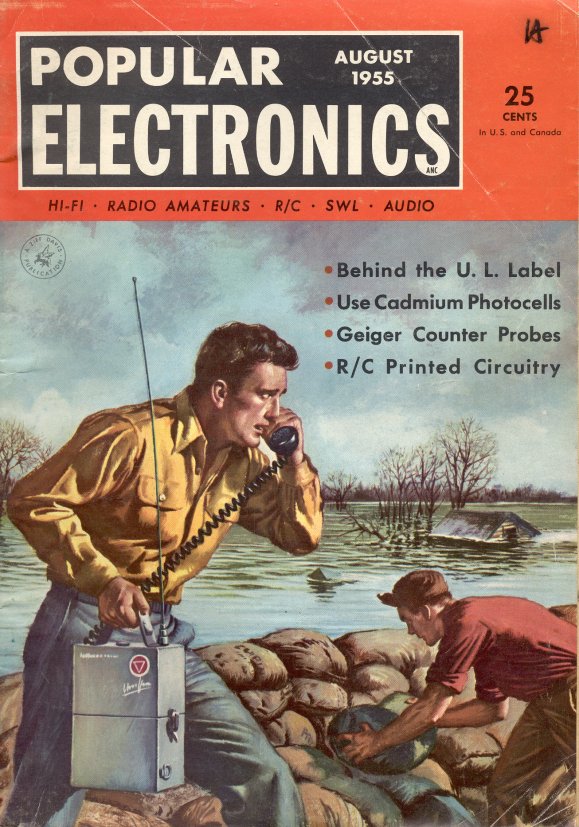
A square-jawed hero and his life-saving Civil Defense 2-way radio—talk
about the late-night fantasies of young solder-scorched nerds! Less
dramatic but no less indicative of the 50's zeitgeist was
the July 1955 issue, which was largely devoted to the uranium prospecting
craze of that era. Build your own Geiger counter, go out into the
still-empty West, and let the riches of the atom announce its presence
into your 2000-ohm headphones:
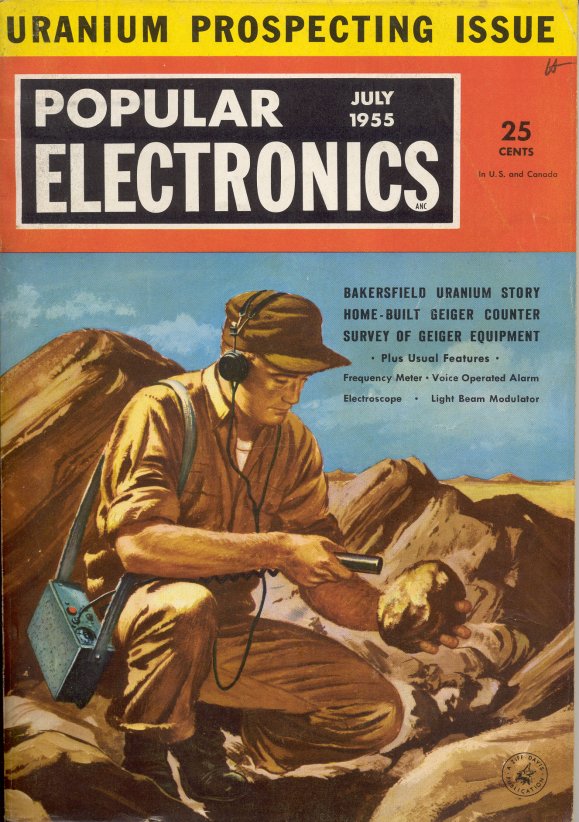
(By the way, I'm sure that there's a name for that style of cap.
What is it? Can I get one? I already have the headphones.)
The watercolors went away in early 1956—my guess is that the
artist started demanding a bigger cut—and the covers became
photographic. Gadgetry and women, often in extremely unlikely juxtapositions,
soon dominated the design. This must be what some calculating New
York art director figured would bring in the maximal nerd audience:
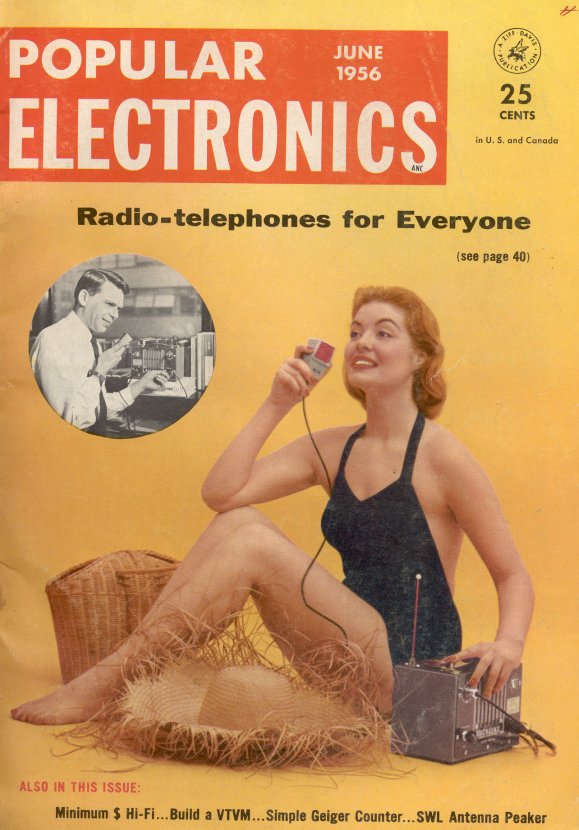
Gosh! Radio-telephones for everyone—even redheads! (The article
on p. 40 was actually a single page about the new Class B 465 MC
Citizens Band, and the redhead was nowhere in sight.)
Skimming the mags themselves has been a lot of fun, and it's interesting
to see that the nerd passions abroad in 1956 are still with us:
Radio-controlled planes and robots, communications of all kinds,
audio equipment, and even computers, though more as objects of awe
("Gigantic electronic brains!") than something to be tinkered
together in the basement. I hope to do another entry here on some
of the ads in the mid-50s mags. The Knight Kit Space Spanner! CK768
RF transistors! "You can make more money with an FCC license!"
American Beauty Electric Soldering Irons!
No, I wouldn't want to go back there, but damn, some of that stuff
calls to me!
|
 October
18, 2006: My Personal Security Program October
18, 2006: My Personal Security Program
Several people wrote (of yesterday's entry) to ask that if I disapprove
of Symantec's security solutions, what do I recommend? And what
do I use myself?
First of all, it's not entirely about software, and certainly not
about one product. One package from one vendor can never be the
solution to everything. What I do is fairly simple, and I have little
or no problem with malware. Here's what I recommend, because here's
what I do, in decreasing order of importance:
- Be behind a router. They're cheap, and extremely strong
protection from unsolicited outside connections from script malware,
which studies have shown scan your IP address every few seconds.
Even if you only have one PC in the house, get a router. They
contain a Network Address Translation firewall, and most allow
you to block specific ports. The one I use is the Linksys 8-port
router/switch, model BEFSR81.
- Don't use IE. Just don't. Almost anything is safer. I
have it installed because the occasional nitwit Web site won't
render correctly without it, but IE often goes untouched for months
on end. Use either Mozilla
Firefox (which is free) or Opera,
which has also been free for about a year now, and is superb.
- Make sure "install on demand" is turned off in
your browser. Certainly, if you run IE at all, this is desperately
necessary.
- Don't use either "big" Outlook or Outlook Express
for email. These are malware magnets largely because they're
so popular, but they also have some fundamental problems that
make them spam facilitators. (They also use IE to render HTML-formatted
email, which makes them vulnerable to most of the same exploits
that plague IE.) I used Poco Mail for a long time, but recently
abandoned it for corrupting my mailbase. I use Mozilla
Thunderbird now, and am quite happy with it, even though Poco
has a few nice features that I miss on occasion.
- Don't surf to porn, warez, or obscure music sites, especially
those that offer deals that seem too good to be true. These are
the primary source of browser exploit trojans.
- Research every piece of "free" software you install,
thoroughly—and resist installing stuff on impulse. This
especially includes browser toolbars and ridiculous crap like
those heavily advertized smileys, which are highly malevolent
spyware and have gotten some of my nontechnical friends into a
world of trouble. If you must fool with such stuff, buy a copy
of VMWare Workstation 5 and learn how to use virtual machines
(VMs) as software testbeds. I test everything I download in a
VM before I ever think of installing it directly on the hardware.
Stuff that I end up not using much I just leave in a VM image
on my very big hard drive.
- If you must surf to dicey sites, do so from a browser operating
in a VM. I go to ebook pirate sites regularly watching for
pirated Paraglyph material, and when I do so, I pinch off a new
image of a standard VM and then revert it to the stored image
when I'm done, whether it looks like I was attacked or not.
- Use a low-profile virus checker like AVG. I have used
AVG Free for some
time now, having also tried Panda and found it too resource-hungry.
Viruses are less of an issue than they used to be, especially
if you're not so stupid as to open any email attachment that rides
in the door, or install warez downloaded from P2P networks.
- Use a two-way software firewall. I use Zone
Alarm and have some some years now. It allows me to control
what actually gets out to the Internet, and it lets me know when
any app even tries to connect. Much modern software, even if it's
completely legitimate, wants to "phone home" for reasons
never entirely explained. ZoneAlarm puts an end to that. Also,
if you contract some kind of spyware or trojan, ZoneAlarm will
let you know when the bad stuff tries to make an outside connection.
That's what I do. Interestingly, I don't do something that makes
a lot of sense, and I really should try it: Run Windows as something
other than admin. If you create and work from within a limited-permissions
account, malware based on exploits (or anything else, for that matter)
cannot install itself. You have to reboot into admin to install
software, but how often do you actually install software? If you're
configuring Windows for a non-technical person who is primarily
interested in Web and email, and perhaps word processing, this is
a very good thing to do. Unfortunately, some software doesn't work
correctly in limited user accounts, and you may not know which software
fails until you try it.
Finally, before all my Mac friends start yelling, you can buy a
Mac. Macs are largely immune to malware because the machines are
fairly rare and sparsely connected (compared to Windows) and malware
authors are looking for raw numbers. However, if Apple would ever
get its head out of its own you-know-what and decide to become a
major player, the bad guys could turn their attention to OS/X. I
have not yet been convinced that Mac software is somehow inherently
exploit-free—and I think complacency would be a very
bad thing.
So there you have it. Note that a lot of my list cooks down to, "Don't
be an idiot." It isn't all about software. It's about common
sense and a little caution. The best trainable, configurable anti-malware
system is you.
|
 October
17, 2006: Battling Symantec October
17, 2006: Battling Symantec
I wonder sometimes what poor Peter Norton thinks of the software
that now carries his name. I just got back from spending over two
hours with a friend, picking fragments of Norton Antivirus out of
his machine with a tweezers. I met Peter a couple of times in the
1980s, and he was a completely pleasant guy, if kind of quiet. I
used his stuff for a lot of years. I certainly won't use it again,
and it has nothing to do with him.
What used to be Norton products are now owned by Symantec. There
are two problems with Symantec's security products. (I have no experience
with their other stuff.) To wit:
- The security stuff is so feature-bloated that it will reduce
even the fastest machine to a crawl.
- It is virtually impossible to uninstall in the conventional
manner, by way of a Windows uninstaller.
Symantec makes the case that our malware situation is so bad that
a really comprehensive security solution can't help but slow a PC
down. There is some truth in that, if you feel you have the right
to go anywhere online and click on anything you see without consequences,
especially if you're running IE. A relatively simple strategy, like
being behind a router, turning off browser install-on-demand, not
opening arbitrary email attachments, and resisting the urge to visit
porn sites will get you 80% of the way there without making your
system run like a PII-450.
Uninstallation problems are less excusable. Forget the conventional
uninstaller. It just doesn't work. To get rid of Symantec security
products you have to download the Norton Removal Tool from Symantec's
site and run that—but as I found earlier today, that's no guarantee.
When I ran NRT on Dean's machine, it got a certain ways along before
telling me that WinFax Pro was installed, and I had to uninstall
that first before running NRT. NRT then aborted.
One problem with that: Nowhere that I could see on that system
was any least trace of WinFax Pro, and Dean had no memory of ever
seeing or using it in the past. That left me the hard way: descending
into the Registry to nuke hundreds of Symantec keys, manually disabling
seven or eight Symantec autostart services, and deleting hundreds
of megabytes of Symantec files. When we were done, the machine ran
again like the 2.4 GHz P4 it was born to be. Degunking R Us.
Symantec gets away with this because its stuff is preinstalled
on virtually any new machine you can buy over the counter right
now, and most people will just pony up the money after the 90 day
"trial" (in several senses of the word, heh) than try
to pry the thing's ugly little claws out of their systems. Not me,
boy. The first thing I do with any new machine is whatever it takes
to get every last stain of Symantec off the hard drive. However,
since I will probably have to assemble my own machines from now
on to avoid the Vista tax, I will avoid the Symantec Disease as
well.
Do it if you can. The cure is almost as bad as the disease.
|
 October
16, 2006: Just-In-Time Bookstores October
16, 2006: Just-In-Time Bookstores
Chris Gerrib
posted a link today to an
article in the (London) Sunday Times, about what might
happen to bookstores if we can ever get the cost of one-at-a-time
book manufacturing down to something that competes with conventional
book printing and binding.
It's worth reading, if you bear in mind that the author of the
piece doesn't completely understand the problem. Much of the disruption
in retail bookselling is due to massive discounting by online retailers
like Amazon, which forces B&M (bricks'n'mortar) bookstores to
meet discounts, at least on popular books. B&M bookstores in
turn force some of their infrastructure costs back on publishers
by charging for preferred positioning of books. And squeezed publishers
then force some of those costs back to authors by cutting advances
and royalty rates. (Authors are still looking for somebody to force
those costs back to.)
My own opinion is that publishing as an industry still has immense
overcapacity from the 90s, triggering a race to the bottom led by
large publishers that need to keep staff and facilities busy. Publishing
would be well served if about half of publishers went out of business,
heh. You first, Alphonse...
Closer to the heart of the problem is the inability to predict
sell-through of any given title. That was in fact the topic of a
longish article by Jeffrey A. Trachtenberg on the front page of
today's Wall Street Journal. (I don't think the piece is
online anywhere but the WSJ paid site.) Publisher Henry Holt
& Co. took a bath on what they considered a "sure thing,"
a novel called The Interpretation of Murder. They paid $800,000
for the book (a first novel by an unknown writer) and printed 185,000
copies. Even though early reviewers loved the book, the public did
not. We won't know for awhile how many of those 185,000 copies will
ultimately have to be pulped, but my guess is, well, most of them.
There are other damaging problems afflicting publishing, primarily
the concentration of control in a mere handful of people at two
massive retail chains, but the question of capital tied up in roll-the-dice
books that may never sell is probably worse. (That is what ultimately
put Coriolis Group Books out of business in 2002.) The Times
article linked to above suggests that bookstores as we know them
will ultimately be replaced by small storefronts at which purchasers
can order basically any book, which is immediately printed and bound
by a machine in the back room, with a click-to-clunk time of only
minutes. People (myself included) have been predicting that for
seven or eight years, ever since the Docutech-class
of book manufacturing machines hit the streets. Close...but not
quite.
Book manufacturing will eventually move to the same premises as
book retailing, but with a twist: Books will still sit on shelves
for browsing, and purchasers will still roam the aisles, picking
out books and carrying them to the checkout counter. The difference
is that all of those books were printed in the basement, and as
soon as one is sold, the monster book-o-matic downstairs will queue
up another one. Front-line staff will constantly grab books from
the book-o-matic's output bin and run them upstairs, where they
will be re-shelved at the places from which purchased copies were
taken. Currently popular books (think John Grisham or Harry Potter)
will be printed in tens or twenties rather than ones or twos, but
the stock depth will be dictated by an algorithm that monitors sales
over time. Obscure titles may not be reprinted and restocked immediately
after their shelf copies are purchased, and huge numbers of older
and marginally viable titles will not be printed at all until they
are actually ordered. The news there is still good: Grab a cup of
coffee and in five minutes (depending on machine traffic) The
Secret Tofu Recipes of 33rd Order Masons will be handed to you
by a beaming young store staffer.
This is not print-on-demand so much as just-in-time manufacturing,
and while it will not eliminate wasted paper copies completely,
it could cut waste and returns from thousands or tens of thousands
of printed copies to something south of a hundred, which is a capital
hit any publisher can absorb. We would still have bookstore aisles
to meet attractive people in, with books to browse and serendipity
around every corner. Publishers will still waste money promoting
bad books, but the money wasted will be less. With less wagered
on every roll of the dice, publishers may be willing to broaden
the base of their frontlists and take more chances on more people.
The long tail would get longer and perhaps even fatter, since no
book would ever really become unavailable.
I think economics will force book publishing and retailing to a model
something like this, but the technical challenges of putting that
kind of machinery in every bookstore (and keeping it running!) shouldn't
be underestimated. Think fifteen years, not five—and the sooner
the better!
|
 October
15, 2006: Nunsuch October
15, 2006: Nunsuch
 Pete
Albrecht send me a picture of a toy he found in what's left of the
American Science Center
catalog, from a place on the northwest side of Chicago where I spent
most of my discretionary cash that didn't go for books when I was
a teen. The toy is a rubber-band powered gun that shoots little
plastic nun figures. It's called (cringe) a "Nunchuck." Pete
Albrecht send me a picture of a toy he found in what's left of the
American Science Center
catalog, from a place on the northwest side of Chicago where I spent
most of my discretionary cash that didn't go for books when I was
a teen. The toy is a rubber-band powered gun that shoots little
plastic nun figures. It's called (cringe) a "Nunchuck."
The device isn't remarkable; similar toys exist that throw plastic
pigs and plastic cats. What I find remarkable about the Nunchuck
(and many other nun-toys like boxing nun puppets and wind-up walking
plastic nuns that shoots sparks out of their mouths) is this: When
was the last time you actually saw a nun? Basically, how is
it that young people (under 30 or so) even know what a nun looks
like these days?
Nuns were once a part of the American landscape. The big Marshall
Field's department store in downtown Chicago (now gutted to irrelevance
as a Federated) used to have a separate ladies' room for nuns. I
saw the (locked) door reading "Nuns' Lounge" myself on
a higher floor, and wondered as a young child what a lounging nun
would look like. Everybody remembers Sally Fields' 1970s TV series
"The Flying Nun," and "perky nuns" got their
own entry (unfairly, I think) in The
Encyclopedia of Bad Taste, right after "Pepper mills,
huge."
Nuns vanished from the American scene to a great extent by the
early 1980s; I think they were gone from my grade school before
that. Many smaller orders of religious sisters have vanished completely,
and the larger orders are now mostly reduced to elderly nuns caring
for extremely elderly nuns. The sisters who remain do not wear the
elaborate habits that our culture remembers; in fact, their dress
is often simple and plain enough to be mistaken for that of a soccer
mom.
What we may be seeing here is the visible manifestation of a more
subtle truth: Nuns were a force to be reckoned with. They
were the people who made Triumphalist Catholicism happen, down on
the street and in the classrooms, by the pure force of their wills
and personalities. Many were very lonely, unhappy women, and that's
where the bad press comes from. Not everybody can be a runway model
or a firefighter, and not everyone can be a nun. But the women who
were born to the manner and stuck with it throughout their lives
were genuine heroes.
And I think nuns have stuck to our cultural consciousness because
of that heroism, not because of the psychological problems that
some had. My own Sr. Maristella (my oldest cousin, now in her 70s)
is one of the kindest and most soft-spoken people I've ever met,
and although there were some whacko nuns in my own grade school,
most of the nuns I had managed classrooms containing 48 or even
50 rowdy kids with an equilibrium (and in some cases a sense of
humor) that no one appreciated at the time.
We remember nuns because they are now mythic creatures, much like
steam trains, which built America with the same impressive mythic
power. Nuns had (and still have) a grip on our imaginations. Heroism
and true power do that in a way that deviousness does not. (Quick:
Show me a toy that tosses little plastic senators!)
|
 October
13, 2006: Odd Lots October
13, 2006: Odd Lots
- One very useful application of Flash lies in posting schematic
diagrams. I took the Visio schematic of my 6T9 tube stereo amplifier,
exported it from Visio as a .AI file, imported the AI file into
Flash, and then exported the diagram as a .SWF file. The SWF is
only 22KB in size, which is much smaller than a TIF of
similar resolution would be and comes down in a fraction of the
time. Take
a look. It prints well from Firefox, with the sole glitch
that the art does not appear in the print preview screen.
- I pass this
along only because Herman's Hermits' "No Milk Today"
is one of my all-time favorite pop songs—and for the sake
of an animated bouncing udder. As silly as anything I've seen
in some time. Maybe a very long time.
- Jim Strickland sent me a pointer to this,
which I would perhaps consider even sillier if it didn't border
on "too true to be funny" territory.
- Make sure you get one
of these before your next all-geek cocktail party.
- I take a certain amount of heat for building and flying kites.
How immature, heh. But
lo! I may be getting my revenge. (How soon before this gets
into Popular Mechanics?)
|
 October
12, 2006: Resurrecting a Computer Book on Lulu October
12, 2006: Resurrecting a Computer Book on Lulu
Back in 2001, Julian Bucknall published The
Tomes of Delphi: Algorithms and Data Structures with Wordware
Publishing, and it became something of a legend. The book's been
out of print for awhile, and used copies are selling on Amazon Marketplace
for $200 and up. Whoa.
There's definitely a message in that market. With rights now reverted
and in-hand, Julian has republished the book on his own through
Lulu.com. You can now
order that $200 book for $25. Wordware sent me a review copy
when it first came out in 2001 (alas, too late to review in Visual
Developer Magazine) though it disappeared somewhere along
the way. I just ordered a new copy, but my memory of the book is
still solid: If you do anything in Delphi beyond stringing components
together with one-line event handlers, this book needs to be on
your shelf.
That would be good enough news right there, but Julian's gone further:
He's written a three-part article on how he went about re-creating
and re-publishing the book, which stands as the best single description
of the print-on-demand publishing process that I've yet seen. Part
1. Part
2. Part
3.
If you have any least interest in print-on-demand publishing, read
them closely and in order. A number of lessons emerge from his experience:
- Publishing at book length is now possible for almost anyone.
It's still a lot of work, but there are no real gatekeepers, as
there are in conventional publishing. You don't have to persuade
anyone to list or carry your book. You follow the process, and
it's published.
- There is very little real money in print-on-demand (POD) publishing.
This has been true since the dawn of POD time. What is said less
often is that there is very little real money in conventional
publishing anymore, either.
- The real strength in POD publishing is re-publishing out-of-print
books to capture "long tail" demand. Julian's book is
exceptional in that regard, in that the book had an unusually
good reputation in its first life, rather like Michael Abrash's
Graphics Programming Black Book, a 1,340-page behemoth that
we published at Coriolis in 1997. Used copies were selling in
the $80 range until relatively recently.
- But that said, POD publishing is extremely length-sensitive.
Unit manufacturing cost is 2c per page plus $4.55. Julian's book
is 524 pages long, so its UMC is $15.03. That's over twice (and
approaching three times) what it would cost to print each copy
in 4,000 copy quantities using a conventional offset press. Michael's
book would have a UMC of $26. Ouch.
Julian tells us that he has sold 110 copies in one week.
That's little short of astonishing, though some of that is probably
an initial blip of pent-up demand. Books like this are less version-sensitive
than most computer books, so there's a good chance that the book
will sell steadily for years to come. And one overwhelming advantage
of Lulu-style self-publishing is that the author does not have to
warehouse books, process orders and payments, dun deadbeat retailers,
or handle the inevitable bookstore returns.
Julian speculates (and I agree) that POD books should go for depth,
not breadth. It might be better for all parties if POD books were
shorter (100-200 pages) and priced at about $20-$25. (I think that
Julian underpriced his book by $5-$8 and consider it a honking bargain.)
Based on his experience, I am considering taking my book Degunking
Your Email, Spam, and Viruses and breaking it up into three
separate books along the obvious topic lines, updating them, and
publishing them on Lulu. I don't expect his kind of success with
it, but the book reviewed well enough for me to think that it still
has some value.
My efforts to publish on Lulu were stymied for months by a weird routing
problem that I recently solved (see my entry for September
20, 2006) and it's time to get back on the task. More here as
it happens.
|
 October
11, 2006: Review: The Mars Run October
11, 2006: Review: The Mars Run
 William
Langewiesche's cover story for the September 2003 Atlantic
("Anarchy at
Sea") was a riveting description of high-seas piracy as
it happens now. None of this "arrrrr, matey" stuff.
It's about multiply nested shell corporations, illusory ship registrations,
an utter lack of law enforcement on the high seas, and (especially)
assault rifles. Although I've read of "space pirates"
in cheap novels for forty years, all of them have leaned toward
the kind of nitwit romanticism that has ultimately given us Pirates
of the Caribbean and a lot of funny hats. William
Langewiesche's cover story for the September 2003 Atlantic
("Anarchy at
Sea") was a riveting description of high-seas piracy as
it happens now. None of this "arrrrr, matey" stuff.
It's about multiply nested shell corporations, illusory ship registrations,
an utter lack of law enforcement on the high seas, and (especially)
assault rifles. Although I've read of "space pirates"
in cheap novels for forty years, all of them have leaned toward
the kind of nitwit romanticism that has ultimately given us Pirates
of the Caribbean and a lot of funny hats.
Not this one.
Chris Gerrib's first
novel is about space piracy in a near future (the 2070s) in
which commerce among Earth, Mars, and certain asteroids has become
routine. The story is told from the point of view of a 19-year-old
girl whose disfunctional family cannot help her with conventional
college tuition, so she enlists in a sort of space merchant marine
academy and becomes a bottom-rung astronaut. On her first run to
Mars her merchant ship is attacked by pirates, and she is given
a choice: Join us as a pirate, or die on the spot. She joins, intending
to escape as soon as possible, and travels on to Mars and back to
Earth, where she spends some time in the pathetic Central African
Empire (a real country of sorts, albeit one where the emperor had
the bad habit of eating his subjects) which is creating a spit-and-baling-wire
space navy specifically to prey on spacecraft from developed nations,
including the US. Janet eventually triumphs, but it's a difficult,
degrading road, which sees several abortive escape attempts and
some time spent as a sex slave of the son of the pirate ringleader.
This is a first novel, and for a first novel (I've read more than
a few) it works quite well. Chris is a Navy man and has spent considerable
time on shipboard, so his descriptions of the nuts'n'bolts of long-haul
space travel ring very true. He also has an intuitive grasp of the
criminal mind, and we get a clear picture of the pirates as reckless,
clumsy opportunists who succeed by a small measure of skill and
a great deal of luck—which eventually (as with all criminal
luck) runs out.
The great flaw of the book is actually a shortcoming of the medium:
We have a size eight novel built on a size six frame. The story
sucked me in and moved me along, but there was a bare-bones feeling
about it, and I kept wanting more of the background of the future
that he's painting here. Janet Pilgrim's character development was
present and adequate, but I felt that, given her circumstances,
I would have liked to know more about the woman she rapidly becomes
once she leaves the Earth. Even with her as the viewpoint character,
a great deal happens "off stage."
After talking about it with Chris, the explanation was clear, and
something entirely new in SF publishing: The constraints of the
print-on-demand publishing medium. The Mars Run was published
through Lulu.com, where the unit manufacturing cost (UMC) is directly
proportional to the page count. Chris calculated the length of the
novel that would allow him to make money while keeping the cover
price in line with conventionally published trade paperback SF,
and he wrote to that length. As I discovered while writing The
Cunning Blood, a given story wants to be told at a given length:
What I had hoped would be a 90,000 word novel turned out to be 145,000
words instead. Chris found the discipline to keep the word count
down, but at the cost of the story's backdrop fading into a necessary
indistinctness.
That's really a vote of confidence from me. The action was straight-line
and almost continuous, once we got past a slightly slow beginning.
I would gladly have read it at twice the length. There's only one
caution: Although the protagonist is only 19, the story has some
very violent moments and there is a fair bit of explicit sex, so
it is not something you should hand to young readers.
And one other interesting note: Lulu sells the book both in printed
form and as a PDF-based ebook. I bought both, and read the novel
twice, once in each medium. (I read the PDF on my Thinkpad X41 tablet
while shivering in the corner of our unheated RV on our peculiar,
blizzard-haunted
"late summer" camping trip up in the mountains.) The
DRM-free PDF sells for only $2.68, and you get it Right Now. (Shipping
time for the print edition is perhaps a day or two slower than what
you'd see with Amazon.) I was interested in seeing how good Lulu's
order fulfillment is, and was very happy with the results.
187 pages. Paperback
$10.96. Ebook $2.68. ISBN 978-1-4116-9973-1.
It's about the future, in more ways than one. Recommended.
|
 October
8, 2006: Finally, Bev Bivens on CD October
8, 2006: Finally, Bev Bivens on CD
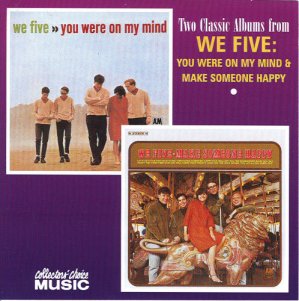 A
very long time ago, I bought the first We Five album (on vinyl—this
was 1966) and dropped it on the basement floor, taking a huge chunk
off the edge. I had played it maybe twice; if my parents had been
home at the time, they might have heard a few brand new words out
of me, right up through the floor. Somehow I couldn't bear to buy
it again, especially with so much to choose from and so little money
to actualize my choice. And I never thought to look for it again
until a few weeks ago, and was delighted to find that the first
two albums from We Five are now available on a single CD. A
very long time ago, I bought the first We Five album (on vinyl—this
was 1966) and dropped it on the basement floor, taking a huge chunk
off the edge. I had played it maybe twice; if my parents had been
home at the time, they might have heard a few brand new words out
of me, right up through the floor. Somehow I couldn't bear to buy
it again, especially with so much to choose from and so little money
to actualize my choice. And I never thought to look for it again
until a few weeks ago, and was delighted to find that the first
two albums from We Five are now available on a single CD.
Most of you have probably never heard of We Five, and at most you
may have heard their sole hit, "You Were On My Mind" on
the oldies stations or in K-Mart. The group was in fact a musical
framework for one of the most amazing female voices to come out
of the 1960s: Beverly Bivens. (Not to be confused with 70s artist
Beverly Bremers. Please.) In my estimation, only Karen Carpenter
ever topped her for smoothness, purity of tone, and vocal emotion.
There is excellent vocal harmony here, especially in "Softly,
as I Leave You," but without Bev, there wouldn't be much to
comment about.
We Five was odd among 60s groups for a number of reasons, perhaps
the most significant of which is that they didn't try to write their
own music to pad out their albums, but preferred to do quirky covers
of Broadway show tunes, like "I Got Plenty of Nuthin,"
"Tonight," "My Favorite Things," "Softly
as I Leave You," and "Small World, Isn't It?" as
well as covers of pop songs made famous by others, like "Cast
Your Fate to the Wind." This makes the disc completely listenable,
something that isn't always the case with albums. There are a few
loser cuts, but I almost found myself hearing them with a pang of
nostalgia. Some of the arrangements do not work well, particularly
"I Can't Help Falling In Love With You, which is too fast (and
has a little too much Spanish guitar) to do justice to the lyrics.
But overall, it's a fine collection, and Bev Bivens can certainly
make a song work that would simply sink without her amazing voice.
You may have to be an Almost Old Person like me to love it like I
do, but hell, that's what blogs are for. Highly recommended.
|
 October
7, 2006: How We Used to Grow the SF Market October
7, 2006: How We Used to Grow the SF Market
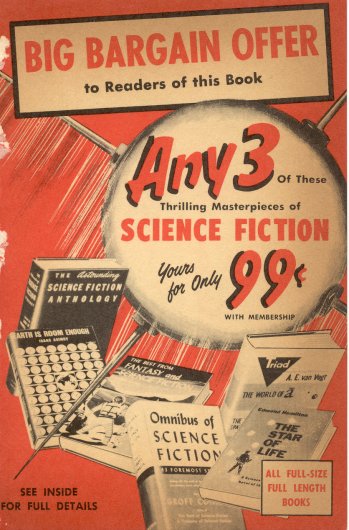 Back
when Carol and I were in Chicago this summer, cleaning out her mom's
house, we found a lot of old books, some of which had been in the
basement for a long time and (quite apart from their yellowing and
brittleness) just smelled. One was a 50c mass-market paperback murder
mystery from 1961, and although the book fed the dumpster, it had
a couple of familiar bind-in postcards promoting the Science Fiction
Book Club. Back
when Carol and I were in Chicago this summer, cleaning out her mom's
house, we found a lot of old books, some of which had been in the
basement for a long time and (quite apart from their yellowing and
brittleness) just smelled. One was a 50c mass-market paperback murder
mystery from 1961, and although the book fed the dumpster, it had
a couple of familiar bind-in postcards promoting the Science Fiction
Book Club.
Like most people, I subscribed to the SFBC for some years in the
70s, and it had an interesting effect on me: I read stuff I wouldn't
have chosen on my own. Some of the lousier titles in that group
are long gone, but two of the better ones that I still have are
The Winter of the World by Poul Anderson and The End of
the Dreams by James Gunn. I don't much like heroic fantasy,
and I find cover paintings of impossibly endowed women in brass
bras a little off-putting, but Anderson's story sucked me in and
I felt that I had gotten my money's worth. I think Gunn's book was
the first of his that I ever read, and I liked it enough to hunt
down the rest of his material.
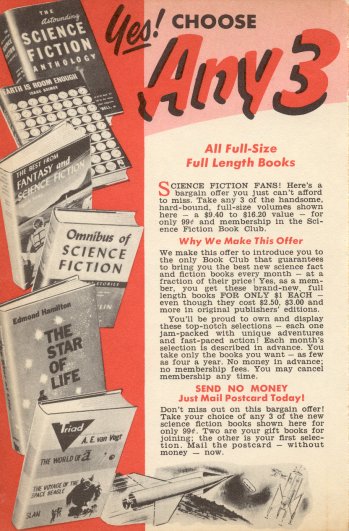 So
the SFBC was a brilliant concept: Push stuff at people, having given
them limited but not absolute choice, and you will broaden their
tastes, and thereby broaden your market. The fact that they placed
their postcards in books without any least relation to SF (like
murder mysteries; who knows where else they went?) was something
that wasn't clear to me at the time, but it's just the next highest
level of the same concept: Get people curious about what they haven't
seen yet. It helped that reading was a popular pastime back then;
a lot of people bought stuff "just to have something to read"
and weren't especially picky about what it was. Give them limited
choice ("choose any three!") and they'll feel like they
had a hand in the decision, while the real choice is made back at
the central office. So
the SFBC was a brilliant concept: Push stuff at people, having given
them limited but not absolute choice, and you will broaden their
tastes, and thereby broaden your market. The fact that they placed
their postcards in books without any least relation to SF (like
murder mysteries; who knows where else they went?) was something
that wasn't clear to me at the time, but it's just the next highest
level of the same concept: Get people curious about what they haven't
seen yet. It helped that reading was a popular pastime back then;
a lot of people bought stuff "just to have something to read"
and weren't especially picky about what it was. Give them limited
choice ("choose any three!") and they'll feel like they
had a hand in the decision, while the real choice is made back at
the central office.
Today, with Amazon allowing us razor-sharp choice in our reading,
we tend to narrow our tastes until we start complaining, "Ten
million books and nothing on!" It makes sense to read outside
your core tastes, but nothing compels us to do that anymore. And no
matter how much we may say we value recommendations calculated to
our precise tastes (in wine, books, music, and anything else of an
aesthetic nature) there is something delightful about stumbling across
something you enjoyed but would never have chosen on your own. That
was what the SFBC was about, and I wonder if there's any future in
such a "surprise me!" mechanism in our heavily networked
age.
|
 October
6, 2006: What I Mean When I Say "Flash" October
6, 2006: What I Mean When I Say "Flash"
If I learned anything in the wake of yesterday's entry, it's that
different people are touching entirely different parts of the elephant
when they talk about Adobe's Flash. For most people, Flash is still
the animated movie-maker that it's been since the very late 1990s.
(And people really really hate Flash splash screens!) But
non-artist that I am, that's not the aspect of Flash that interests
me.
What I see when I think "Flash" is a mechanism for coding
up and deploying RIAs (Rich Internet Applications) that (preferably)
contain no animation at all. The platform that Adobe created for
doing this with Flash is called Flex. The
Flex platform is conceptually similar to AJAX, but seems way
less haywire to me.
Flex consists of three major elements:
- ActionScript 3.0, which is an object-oriented scripting language
superset of ECMAScript.
- MXML, which is an XML-derived markup language for defining UIs
and data bindings.
- The Flex Class Library contains components including controls,
data containers, and data protocol managers.
A Flex compiler compiles all three of these elements into a binary
file with the extension .SWF. The SWF file is loaded and run by
the Flash Player (almost always a browser plug-in) which contains
a bytecode virtual machine and a JIT compiler. The jitter compiles
the SWF to native code as needed. When you've got a finished and
debugged SWF, you publish it to a Web host where people can request
it via HTTP and execute it via their Flash Player browser plug-in.
As with most compiled languages, you can write source code files
in any old text editor and then compile them to SWF with the free
command-line compiler that Adobe makes available. But I was delighted
to see that Adobe has implemented a Flex IDE using Eclipse. The
product is called Flex
Builder, and I just installed the trial version this afternoon
to take a look. The Eclipse implementation is very good, and even
has a Delphi-like drag-and-drop palette for Flex components. The
Adobe site has some nice tutorials, and I was able to create a (trivial)
app in twenty minutes, allocating abundant time to poke at the IDE
and understand what it was I was actually doing. The $750 price
of Flex Builder is a little daunting, but I will admit, it's very
slick.
So that's what I really mean when I say "Flash": a genuine
programming platform where the focus is code and not eye candy. I
suspect I should cut the confusion by calling it "Flex."
As the Star Child said, I'm not entirely sure what to do with it yet—but
I'll think of something.
|
 October
5, 2006: Odd Lots October
5, 2006: Odd Lots
- Mitch Kapor is redeeming himself from the embarrassment of his
silly look'n'feel litigation days by mounting (and apparently
funding) a very promising Open Source replacement for Microsoft
Outlook called Chandler.
I'm not sure it's quite complete enough to spend much time with
(and sheesh, Mitch! You've been at it for three years now!) but
I'm watching it closely. I've tried a lot of similar software,
but have yet to find anything I could really throw my weight behind.
This could be the one. We'll see.
- I ordered a computer table today from Unfinished Furniture Warehouse,
on Stone St. in Colorado Springs. It's basically a hack of a standard
trestle-based small dining table, in alder wood. They're taking
down the vertical members so that the table surface is 26 1/4"
above the floor, and cutting the table depth from 40" down
to 32". The table length of 72" will be unchanged. For
the stain they're going to match a shelf I took in from one of
my bookshelves here. They have a number of finished pieces on
hand as examples of their work, and I am mightily impressed.
- I'm studying the Flash platform, and it strikes me that Flash
is hugely better than HTML for anything but the simplest
of static Web pages. In fact, Flash is amazingly like Java and
.NET, which must be one of the best-kept secrets of the Web programming
world. What I knew of Flash came mostly from books that Coriolis
published on it circa 2000, which were targeted at graphics designers
and seriously shorted the programming side of the platform.
- Cripes. I'll bet the German police are killing each other to
get put on this
case.
|
 October
3, 2006: My New Chair October
3, 2006: My New Chair

Back in the summer of 1988, when we were still living in Scotts
Valley, Carol and I went up to San Francisco just to walk around,
and we happened into the Just Chairs office furniture store on Bryant
Street. I sat in a few chairs, and somehow one just felt absolutely,
unutterably right. I bought it on the spot, even though the
damned thing cost me $1200, which was more than we had ever spent
for any single item of furniture in our 12 years of marriage.
This almost magical chair was a Grahl Allmatic 8 (above, left),
made in Germany, and it became the chair I sat in to do my computing
for the following 18 years. Back in 1999, the little hydraulic cylinder
in the vertical column split, leaking pale pink oil in a puddle
on my (fortunately) non-permeable chair mat. After that the vertical
position of the chair began to sink slowly with use, and every couple
of days I have to raise it. Since then I've been looking for a replacement.
The leather has been cracking for some time, and is completely worn
away on parts of the armrests. Just before we left for our (long)
summer trip to Chicago, the vertical column seized at its lowest
position, and I knew that it was the end of the line for the Allmatic.
Alas, Grahl Allmatic chairs haven't been available in the US for
a number of years, and it's unclear whether they're still even manufactured.
(The Web site you may see if you search is abandoned, by a dealer
who clearly doesn't understand the value of keeping Web sites current.)
So. I searched, and searched, and plopped my butt in countless
chairs, to no avail. Then, a few weeks ago, Carol and I were up
getting QBit his special dog food at a pet store up on Woodmen Rd,
which is a few doors down from a place called Relax
the Back. In addition to pillows and bed mattress tops, they
had chairs. Out of habit I started testing in my usual fashion,
and then....
Bingo!
It was 1988 all over again. The chair in question is the Lifeform
Ultimate Mid-Back Executive Chair. It...just...fit. It bears more
than a passing resemblance to my old Allmatic, and adjusts in more
ways. It also costs twice as much, though adjusting for inflation
it's only about 30% more than the Allmatic cost in 1988. I don't
much care, considering the proportion of my waking hours that I
sit in front of this damned screen, hammering on the keyboard. I
have a chair again. My rear end is happy. The next step is finding
a computer table at my accustomed height (26" from the floor)
which has also been a challenge. The table I used until we moved
in here was something I cobbled up myself (and ugly) and 26"
is not a standard table height. There's a custom furniture place
up off Fillmore that says they can do it. I need to get their quote,
but it looks good.
Lesson: Computer furniture matters, if pounding a keyboard is how
you make your living. It's interesting that I never had headaches
of any consequence until we moved in to our new house—which
was also when I started using a tall table with a chair that was
on its last, um, legs.
More as it happens.
|
 October
2, 2006: Thirty Years October
2, 2006: Thirty Years
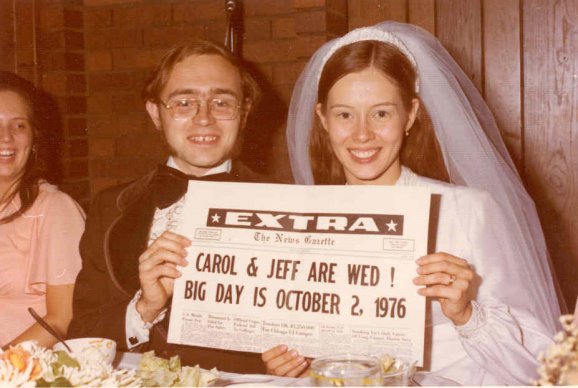
Thirty years ago today, I promised the young woman who had won
my heart that I would stand by her no matter what—and
I'm going to admit here that I had little clear concept of what
I was promising. But how could I? I was an odd young man whose father
had dropped out of the game when I was 16, and most of what I knew
about life and love I had picked up reading other people's tall
tales.
I learned quickly that love, like life, was hard work. Standing
by your spouse does not mean fending off attackers, as my silly
imagination sometimes suggested. I learned over the years that it
means transforming yourself in such a way as to transmute lust into
passion, and self into partnership, passion and partnership welded
together with a bead of unbreakable friendship. This is not easy,
and I'm not entirely sure I know how we did it. If there were attackers,
they grew out of my own weaknesses, but I beat 'em. I saw the same
process working in Carol. ("Work" is the operative word.)
Thirty years on, we have arrived at middle age transformed, completed,
and victorious. Done correctly, that's what marriage is about. It's
possible for single people to reach the same level of transformation
and completion (though I'm sure it takes just as long) but damn,
it's good to walk that path with someone right there beside you!
|
 October
1, 2006: Odd Lots October
1, 2006: Odd Lots
- Larry Nelson sent me a pointer to a
site where you can download free PDF generators for a great many
different kinds of graph paper, including some very odd stuff
(for Americans, at least) like penmanship guide paper for Chinese
ideograms. Music staffs, ledger sheets, guitar fretboard diagrams,
and lots more. Brilliant stuff. All he lacks is "do-it"
list paper. I'll request it; surely that's as important as Palmer
Method for Genkoyushi!
- Bill Higgins attended the Rocket Belt Convention in Niagara
Falls earlier this month, and wrote
brilliantly about it in his blog. I have doubts about rocket
belts as a real-world concept, but of course they're what almost
all geeks dream about. Read Bill's blog starting on September
23 and on for the next few days. (He actually got to try on—if
not fly—the original Bell rocket belt!) Also check out his
convention photos on Flickr. Also do read his
reposted 1992 essay about rocket belts and other unlikely
flying machines.
- Related to the above is an
exhibit of the work of Ky Michaelson, whom Bill Higgins characterizes
as someone as close to a grown-up Tom Swift as humanity is likely
to produce. Get lost in the site for awhile and see if you don't
agree. A rocket-powered wheelchair! Yee-hah!
- Sandisk
has announced 12 GB and 16 GB Compact Flash memory cards,
which should be available by the first of the year. This market
is being driven by very high resolution professional digital photography,
but if you really really need to be able to take 16,000
snapshots on your Kodak pocket camera before dumping to disk,
well, here's your ticket.
- Although the Wi-Fi business has been a little sleepy since Wireless-G
finally happened a couple of years ago, I'm seeing an occasional
flash of brilliance in terms of new niche products. One interesting
approach is to build a USB Wi-Fi client adapter right into a fat
vertical gain antenna, as is done in the
WaveRV system from Radiolabs.
Although positioned for RVs (which is how I ran across it, through
chatter on the Yahoo Groups RV
Communications group) it would work just as well in a car.
There's no microwave cable loss between the client and the antenna,
as all signal is carried between the WaveRV unit and the computer
through a USB cable.
|
|
